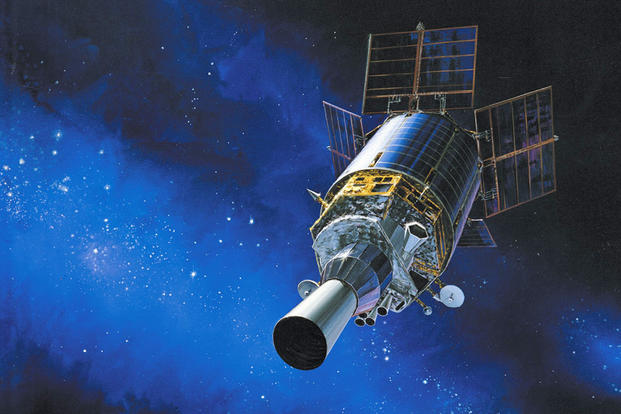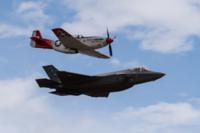Missiles and submarines, nuclear warheads, civil defense, and hotlines between the White House and The Kremlin played major roles in the Cold War experience, but another development played as significant a role and is often overlooked - the development of early warning satellite systems.
In 1956 as long-range bombers gave way to intercontinental ballistic missiles (ICBM), the Central Intelligence Agancy (CIA) warned that "it is possible the USSR, if it sought full strategic surprise, could launch an attack on the continental U.S. without undertaking any observable preparations which would provide strategic warning."
While this warning did not fully foresee the extensive development of ICBMs, it inspired an American effort committed to early detection, first against the threat of penetrating Soviet bombers and later against ICBMs.
The early development involved enormous earth-bound radars that could provide 10-20 minutes warning. A vast network of RADAR stations continues to provide surveillance and warning. Linked together, this network relayed its data to NORAD for analysis and decision making. Despite its success against aircraft, this Ballistic Missile Early Warning System or BMEWS was limited by technology and physical factors associated with ground-based radar.
Recognizing these limitations, Joseph Knopow of Lockheed and Sidney Passman and William Kellogg of RAND began exploring infrared sensors to detect missile launches in 1955. Their recommendations include satellite-based sensors. This idea evolved in to the Missile Detection and Alarm System or MIDAS which first orbited in 1960.
The data from these satellites became the stuff of legends because every reaction and Cold War calculation began with the warning of enemy action. The satellites promised an eight-minute warning of a Soviet nuclear-missile attack. In those eight minutes, plans were constructed for emergency evacuations of key personnel and for the American response. With just an eight-minute-warning strategies like "Launch on Warning" were developed with fearful automated response systems. The eight minutes became the standard warning for Cold War-era civil defense actions and the standard for missile and bomber crew actions.
Despite the dependence that MIDAS inspired, the system was plagued with limitations. With an operational life of one year and a relatively low orbit, MIDAS required many satellites and a continuous schedule of launches. Yet, despite controversy and poor performance MIDAS served as the backbone for America's early warning system for nearly a decade.
The follow-on to MIDAS eventually became known as the Defense Support Program (DSP). Using geosynchronous orbits, DSP required only 3 or four satellite to provide surveillance of the entire earth and promised an effective life of more than three years. These satellites were integrated with the radar systems already reporting to NORAD at Cheyenne Mountain near Colorado Springs. Once analyzed, DSP data provide great detail about Missile activity including the number of missiles, their azimuth, and projected impact points. DSP even provided the capability to detect submarine-launched ballistic missiles.
DSP proved successful in providing reliable early warning and important information about Soviet test operations. During the 1970s and 1980s, DSP completely removed the possibility of a successful surprise attack on the Unites States using ballistic missiles lengthening the eight minute response time to more than 20 minutes in some cases.
But throughout this long vigilance, DSP only first performed in wartime in 1991 during Desert Storm. Called "the most important of all Air Force satellite projects" by General Donald J. Kutnya, commander of U.S. Space Command in 1991, DSP provided warning against Iraqi Scud missiles. This intelligence was shared with allies like Israel during the conflict.
Early warning satellites in the Defense Support Program make up only a fraction of the operational satellites of the Cold War and today's military space programs. Satellites provide comprehensive communications, surveillance, meteorological data and even nuclear test detection.
This last mission of detecting nuclear explosions plays an important part in enforcing the treaties which helped bring an end to the Cold War. Although development began in Defense Department studies as early as 1959, the first satellite aimed at nuclear detonation detection launched in 1963. Called Vela Hotel, the satellites carried x-ray, gamma ray and neutron detectors which could spot a nuclear explosion as far as 100 million miles from Earth. With just two satellites placed in 70,000-nautical-mile orbits, the Vela Hotel satellites could watch the entire globe. The Vela Hotel program ended in 1984 after 21 years of continuous operations. The nuclear detection program blended with other DSP and Navstar GPS satellites using the detection technology from the Vela Hotel program and was renamed the Integrated Operational Nuclear Detection System (IONDS).
As satellite technology continues to move from Cold War deterrence and top-secret status into more mainstream applications and people use satellite televisions, hand-held navigation devices and satellite enabled phones; the contribution of Cold War satellite programs continue long after their primary mission of detection, warning and deterrence.















